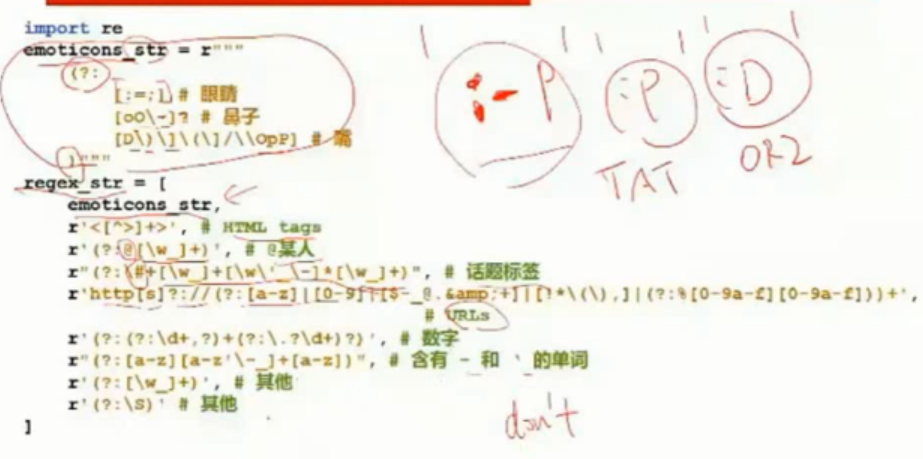NLTK1及NLP理论基础
以下为Aron老师课程笔记
一、NLTK安装
1. 安装nltk
https://pypi.python.org/pypi/nltk
把nltk-3.0.0解压到D:\Anacond3目录
打开cmd,进到D:\Anaconda3\nltk-3.2.4\nltk-3.2.4目录
输入命令:python setup.py install
2. 安装PyYAML:
http://pyyaml.org/wiki/PyYAML(注意Py版本)
下载之后执行exe文件
3. 打开IDLE,输入import nltk,没有错误的话,就说明安装成功了
4. 下载NLTK_DATA
在python shell里面输入
Import nltk
nltk.download()
选择all,设置好下载路径(Download Directory),然后点击Download
二、文本处理流程
(清洗数据(缺失值、噪音数据、平滑处理)--->中文分词(将其转换成占位符,并且去掉一些可有可无的词)--->转换成数值特征提取(tfidf还有其他几种方法) --->特征选择(卡方互信息发IG法等等)--->用机器学习算法跑

中英文NLP最大的区别在于,因为每个词之间是空格分割,而中文都是粘到一起的,所以需要中文分词!Heuristic从字典中反复查阅,保证我们的词可以分成词。中文分词资料:结巴分词github主页 https://github.com/fxsjy/jieba;基于python的中文分词的实现及应用http://www.cnblogs.com/appler/archive/2012/02/02/2335834.html ;对Python中文分词模块结巴分词算法过程的理解和分析http://ddtcms.com/blog/archive/2013/2/4/69/jieba-fenci-suanfa-lijie/

1.Tokenize(把长句子,拆成有“意义”的小部件)
Import nltk
Sentence = “hello, world”
Tokens = nltk.word_tokenize(sentence)
Tokens
复杂的词形,表达相似的意思,需要归一化。其中nltk中提供了很多stemming(词干提取,把不影响词性的inflection的小尾巴砍掉比如walking砍成walk)的方式。


另外还有Lemmatization词形归一,把各种类型的变形都归为一个形式,比如went归一为go,are归一为be。nltk中也提供了Lemmatization。wordNetLemmatizer类似于一个字典网络,里面有各类词的归类,缺点是对于一些新词可能不知道。

Lemmatization还有些小问题,就比如把went认为是go,但实际可能是一个人名“温特”,所以需要指定词性,Part of Speech(POS) tag。

Nltk标注POS tag,然后把词性取出来放到lemmatize里面。

用正则保留一些词使其不被拆分
正则里面(?: )代表它是个大括号,[ ]代码的是里面任何一个,比如下面那个emoticons_str里面,第一个[ ]里面就是可能是: = ,第二个里面可能是- o,后面有个问号代表可以出现或不出现,第三个里面可能是P p D等,其实就是整个是描述表情符:-p :p :D这些。

得到regex_str后先compile一下形成token_re,然后利用token_re(s) s为原文本的str,把符合条件的都筛选出来,这样有些独特的东西就不会被拆分,比如网页这些
2. Stop停用词
一千个the有一千种指事
全体Stopwords列表http://www.ranks.nl/stopwords
Nltk去除停用词

最终, 一条典型的文本处理流水线

三、自然语言处理
什么是自然语言处理,把自然语言处理成计算机能识别的数据
文本预处理得到wordlist后,我们需要得到一些能够表达出这个句子的特征

NLP的经典应用:
1.情感分析
最简单的sentimment dictionary,类似于打分机制,英文比如like 1分,good 2分,bad -2分,有人已经做好情感词典,
AFINN-111 http://www2.imm.dtu.dk/pubdb/views/publication_details.php?id=6010
sentiment_dictionary = {}
for line in open('data/AFINN-111.txt'):
word, score = line.split('/t')
sentiment_dictionary[word] = int(score)
#把打分表记录在一个dict上后
#跑一遍整个句子,把对应值相加
total_score = sum(sentiment_dictionary.get(word, 0) for word in words) #有值就是dict里面,没有就是0
#于是你就得到一个sentiment score
但这个方法仍然有很多缺点,比如新词怎么办?特殊词汇怎么办?更深层次的玩意怎么办?
配上ML的情感分析
from nltk.classify import NaiveBayesClassifier #随手造点训练集 s1 = "this is a good book" s2 = "this is a awesome book" s3 = "this is a bad book" s4 = "this is a terrible book" def preprocess(s): return {word:True for word in s.lower().split()) #把训练集给成标准格式 training_data = [[preprocess(s1), 'pos'],[preprocess(s2), 'pos'],[preprocess(s3), 'pos'],[preprocess(s4), 'neg']] #喂给model吃
model = NaiveBayesClassifier.train(training_data)
#打出结果
print(model.classifiy(preprocess("this is a good book"))
2. 文本相似度;文本分类
1. 高级的feature构造
-Levenshtein Distance(列文斯坦距离)
从string1到string2之间的距离,就是从string1变到string2需要做的删除、添加、替换的步骤数。或者使用Ratio(步骤数/总长度)。
-Frequency
用元素的频率表示文本特征

#TODO 词频统计
import nltk
from nltk import FreqDist
Corpus = 'this is my sentence'\
'this is my life'\
'this is the day'
tokens = nltk.word_tokenize(Corpus)
print(tokens)
fdist = FreqDist(tokens)
#把最常用的50个词取出
standard_freq_vector = fdist.most_common(50)
size = len(standard_freq_vector)
print(standard_freq_vector)
#按照频次出现的大小记录下位置
def position_lookup(v):
res = {}
counter = 0
for word in v:
res[word[0]] = counter
counter +=1
return res
standard_position_dict = position_lookup(standard_freq_vector)
print(standard_position_dict)
#这时如果有个新的句子
sentence = 'this is cool'
#新建一个跟我们标准vector同样大小的向量
freq_vector = [0] * size
#简单的对新句子处理下
tokens = nltk.word_tokenize(sentence)
for word in tokens:
try:
#如果在我们的词库里出现过 那么就在标准位置上+1
freq_vector[standard_position_dict[word]] +=1
except KeyError:
#如果是个新词,就Pass
continue
print(freq_vector)
但是存在另一个问题是词频的大小对于不同的文章是无法去归一化判断的,不像一个比例你知道在0到1之间,越大越好,比如一个单词在某篇文章里面出现100次,在另一个文章里出现1000次,可能100在第一个文章里面算很多,而在另一个文章里算很少,为了解决这个问题,我们产生了一个更严谨的计算方法方式。
-TFiDF
Tf 衡量一个term在文档中出现的有多频繁
TF(t)=(t出现在文档中的次数)/(文档中的term总数)
IDF: Inverse Document Frequency 衡量一个term有多重要,有些词出现很多,但并不重要,比如“is” “this”。为了平衡我们把罕见的词,重要性提高,把常见词的重要性搞低。
IDF(t)=log_e(文档总数/含有t的文档总数)
TF-IDF = TF*IDF

#TODO TFIDF
from nltk.text import TextCollection
#把所有的文档放到TextCollection类中,这个类会自动帮你断句,做统计,做计算
corpus = TextCollection(['this is sentence one','this is sentence two','this is sentence three'])
tokens = nltk.word_tokenize('this is sentence one'\
'this is sentence two' \
'this is sentence three')
fdist = FreqDist(tokens)
standard_freq_vector = fdist.most_common(50)
print(standard_freq_vector)
standard_vocab = []
for i in standard_freq_vector:
standard_vocab.append(i[0])
#直接能算出tfidf
# print (corpus.tf_idf('is','this is sentence four'))
new_sentence = 'this is sentence five'
for word in standard_vocab:
print(corpus.tf_idf(word, new_sentence))
-Word2Vec
#TODO 案例
#TODO Levenshtein
# import Levenshtein
# print(Levenshtein.ratio('hello','hello world'))
# df_all['dist_in_title'] = df_all.apply(lambda x: Levenshtein.ratio(x['serach_term'], x['product_title']))
#
# #TODO TFIDF
# df_all['all_texts'] = df_all['product_title'] + '.' + df_all['product_description'] + '.'
#先把我们所有的文本变成一个大的语料库
from gensim.utils import tokenize
from gensim.corpora.dictionary import Dictionary
dictionary = Dictionary(list(tokenize(x, errors='ignore')) for x in df_all['all_texts'].values)
print(dictionary)
#扫遍我们所有语料,并且转换成简单的单词个数的计算
class MyCorpus(object):
def _iter_(self):
for x in df_all['all_texts'].values:
yield dictionary.doc2bow(list(tokenize(x, errors='ignore'))) #弄成类似于onehot [1,0,1,1,3,1]
corpus = MyCorpus()
#把已经变成BoW向量的数组,做一次TFIDF的计算
from gensim.models.tfidfmodel import TfidfModel
tfidf = TfidfModel(corpus)
#我们看一下放普通的句子长什么样 这里得到的值得size是,句子有多长,size就有多长,而我们要保证每个句子的size一样,所以单独可以写个方法
tfidf[dictionary.doc2bow(list(tokenize('hello world, good morning', errors='ignore')))]
#把每个句子变回成总语料库那么长
from gensim.similarities import MatrixSimilarity
#先把刚刚那句话包装成一个方法
def to_tfidf(text):
res = tfidf[dictionary.doc2bow(list(tokenize(text, errors='ignore')))]
return res
#然后在计算出tfidf的基础上,我们创造一个cosine similarity的比较方法
def cos_sim(text1, text2):
tfidf1 = to_tfidf(text1)
tfidf2 = to_tfidf(text2)
index = MatrixSimilarity([tfidf1], num_features=len(dictionary))
sim = index[tfidf2]
return float(sim[0])
df_all['tfidf_cos_sim_in_title'] = df_all.apply(lambda x: cos_sim(x['search_term'], x['product_title']), axis=1)




